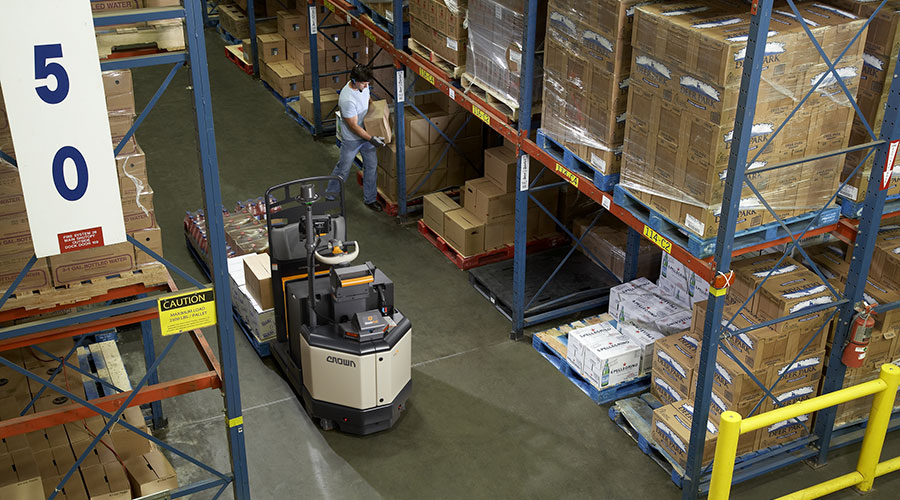Order Picking Is Changing: Are You Changing With It?

For years, the model of picking a single order containing multiple items to completion has been the predominant approach of many warehouses and distribution centers. More recently, consumer behaviors and purchasing habits have put a heavy strain on this approach. Considering the volume of products and the variety of products being purchased through e-commerce, along with the difficulties of hiring and retaining warehouse employees, many have transitioned to what is known as an omnichannel approach.
An omnichannel fulfillment system requires picking and shipping individual items within customer orders from storage locations and fulfilling orders through multiple channels that will produce the most efficient and timely delivery. It enables warehouses and distribution centers to handle a greater volume of pick activity, but it can result in expanded picking locations with accessibility to more products. It may also involve combining different sales and operation systems, or warehouse and fulfillment services, to serve both online and in-store requirements.
Expanded pick locations typically involve operators picking items at multiple levels and even covering more ground in additional picking aisles. This means more vertical and horizontal travel every shift – more work to accomplish using existing resources. Consequently, companies are looking at multiple solutions to enhancing their order picking capabilities.
What about Automation?
When trying to do more with less, the first thing that comes to mind is often automation. That said, there are several important factors to consider before deciding what kind of automation to integrate into your facility and how it will provide a return-on-investment.
If the operation is having difficulty getting people to all of the pick locations, they’re often tempted to try to bring the product to its fulfillment operation. Fixed automation, like conveyors, shuttles, carousels and vertical lift technologies, are often part of these goods-to-person systems. Fixed automation can deliver dramatic improvements in warehouse density and throughput, but it may not be the right solution for every facility or application.
The fixed automation approach cannot easily accommodate frequent changes to input, process or changes in product profiles, including size, weight, shape and particular packaging and handling requirements. It can require high capital investment that may not be warranted if the operation hasn’t experienced or isn’t forecasted to produce sustained, high throughput over an extended period of time. It can also significantly disrupt day-to-day operations while the equipment is being installed and tested within facilities.
An alternative to fixed automation that offers more flexibility is mobile automation, in which automated guided vehicles, including dual-mode forklifts, can be used to perform specific material movements. Forklift technology continues to evolve, providing several options for enhancing and advancing order picking. Since they don’t require significant investments in infrastructure, automated forklifts can generally be deployed with minimal disruption to day-to-day warehouse operations.
Dual-mode automated vehicles can support applications throughout a broad range of size and complexity across many different locations. Trained employees can easily switch from automated to manual operation, then return the vehicles to automated operation once the necessary manual operations are completed. Dual-mode automated vehicles are also more readily adapted to changes in the production plan and more easily scaled as the opportunity for automation grows.
What If Automation Isn’t the Answer Today?
A misconception many companies may have when looking to evolve their order picking is that only advanced technology like automation systems will give them the enhancement and efficiency they need. This is not always the case. Depending on the application, there may be an opportunity to utilize a different type of forklift or use an existing vehicle differently to evolve and improve the order picking process.
Alternatives might include using a pallet truck with forks that raise and lower for multi-level order picking applications. This enables operators to adjust the pallet to pick at height to help reduce bending and stretching, which can avoid back and shoulder strain. Another option might be a pallet truck with longer forks, which equips operators to build two or three pallets simultaneously. If even more picking levels are involved, a man-up order picker could be used to enable operators to pick at higher levels safely and confidently.
Can Technology Help in Some Way?
There are new technologies that can enable operator assist features on some forklifts, which can enhance the skills and expertise of existing operators or help accelerate the onboarding and training of new operators in order picking applications. Operator assist features, such as Crown’s QuickPick® Rapid, can enable operators to remotely advance the lift truck during low-level order picking while it utilizes various sensors to safely travel down the aisle to the next pick location. This allows operators to maintain a smooth workflow pattern while picking behind the lift truck. By eliminating the need to step on and off the lift truck platform and reducing the time required to position the vehicle, these types of operator assist features increase productivity and reduce operator fatigue.
Another example of sensor technology, enabling operator assist features, is the Auto Positioning System (APS), featured on Crown’s man-up order pickers, like the TSP Series. This system can use information provided by the warehouse management system to guide the lift truck along the most efficient path to the next pick location and can be utilized to help new operators become acclimated to the very narrow aisle order picking process. This operator assist feature has proven to increase productivity up to 20% and reduce operator training time by 50% in customer applications.
Consulting with your material handling equipment provider should be the first step taken towards updating your facility for omnichannel fulfillment. Your provider can help identify the forklift(s) and operator assist features that would be most applicable to your operators and facility. They can also advise you concerning what modifications to existing processes, equipment and training may be needed.